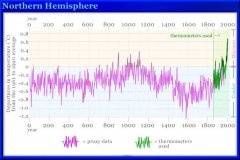Global climate change history
Is the global climate changing? Is the world getting warmer?
Yes. But let’s look more closely at what that means. We can start with the time from 1856 to the present. We have a good record of global temperature for this recent period. Accurate temperature measurements were made at many locations around the world.
There have been some sharp year-to-year fluctuations. During some periods, such as the 1940s, there was a drop in global temperature, but the overall trend is up when we look at the past century and a half.
What if we examine a longer period of time—say, the past 1, 000 years? This presents a problem since accurate records of temperature were not kept prior to the middle of the 19th century. But there are ways of estimating temperature from other information such as the size of growth rings on trees and the composition of ice taken from Antarctica and Greenland. The records used for these indirect measurements of temperature are called "proxy data." Find out more about how temperature estimates are made from proxy data.
The average global temperature has risen in the past 150 years. The period from 1961 to 1990 is the comparison point for this graph. This is represented by the horizontal line at 0. The anomaly, or variation from this average, is shown for each year.
The average global temperature for a given year is indicated by a blue or red dot. For example, the year 1900 was 0.2 C degree (0.36 F degree) cooler than the 1961–1990 average. The warmest year in this record was 1998, nearly 0.6 C degree (1.1 F degrees) warmer than the 1961–1990 average.
The heavy blue and red line traces the average global temperature for five year periods. For example, the average temperature for 1998—2002, which is centered on 2000, was 0.4 C degree (0.7 F degrees) above the 1961–1990 average. The period from 1958 to 1962, centered on 1960, was right on that average.
The next graph shows the average temperature of the Northern Hemisphere over the last two millennia.
The portion to the right of the vertical line corresponds to the time period covered by the first graph—about 150 years. In the context of the past 2, 000 years the late-20th-century increase in temperature is quite sharp. What about the rest of this time span? The period of several hundred years up to the 19th century has been referred to as the Little Ice Age in Europe. The exact dates are not agreed upon. There is much evidence of a cooler climate than exists today or in the warm period from about 900 to 1100. Glaciers advanced. The Baltic Sea and the River Thames in London frequently froze during winter. Growing seasons were shortened. During especially severe winters livestock died in large numbers. The climate was also cooler in the northeastern part of North America. However, it is not clear if the cooling was global or limited to the North Atlantic region.
The purple portion of the line is based on indirect measurements, or "proxy data." The green portion represents actual thermometer readings.



|
How Serious a Threat Is Climate Change? (In Controversy) Book (Referencepoint Press)
|
|
Lies, Damned Lies, and Science: How to Sort Through the Noise Around Global Warming, the Latest Health Claims, and Other Scientific Controversies (FT Press Science) Book (FT Press) |
